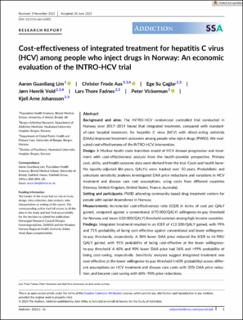| dc.description.abstract | Background and aims
The INTRO-HCV randomized controlled trial conducted in Norway over 2017–2019 found that integrated treatment, compared with standard-of-care hospital treatment, for hepatitis C virus (HCV) with direct-acting antivirals (DAAs) improved treatment outcomes among people who inject drugs (PWID). We evaluated cost-effectiveness of the INTRO-HCV intervention.
Design
A Markov health state transition model of HCV disease progression and treatment with cost-effectiveness analysis from the health-provider perspective. Primary cost, utility, and health outcome data were derived from the trial. Costs and health benefits (quality-adjusted life-years, QALYs) were tracked over 50 years. Probabilistic and univariate sensitivity analyses investigated DAA price reductions and variations in HCV treatment and disease care cost assumptions, using costs from different countries (Norway, United Kingdom, United States, France, Australia).
Setting and participants
PWID attending community-based drug treatment centers for people with opioid dependence in Norway.
Measurements
Incremental cost-effectiveness ratio (ICER) in terms of cost per QALY gained, compared against a conventional (€70 000/QALY) willingness-to-pay threshold for Norway and lower (€20 000/QALY) threshold common among high-income countries.
Findings
Integrated treatment resulted in an ICER of €13 300/QALY gained, with 99% and 71% probability of being cost-effective against conventional and lower willingness-to-pay thresholds, respectively. A 30% lower DAA price reduced the ICER to €6 900/QALY gained, with 91% probability of being cost-effective at the lower willingness-to-pay threshold. A 60% and 90% lower DAA price had 36% and >99% probability of being cost-saving, respectively. Sensitivity analyses suggest integrated treatment was cost-effective at the lower willingness-to-pay threshold (>60% probability) across different assumptions on HCV treatment and disease care costs with 30% DAA price reduction, and became cost-saving with 60%–90% price reductions.
Conclusions
Integrated hepatitis C virus treatment for people who inject drugs in community settings is likely cost-effective compared with standard-of-care referral pathways in Norway and may be cost-saving in settings with particular characteristics. | en_US |

